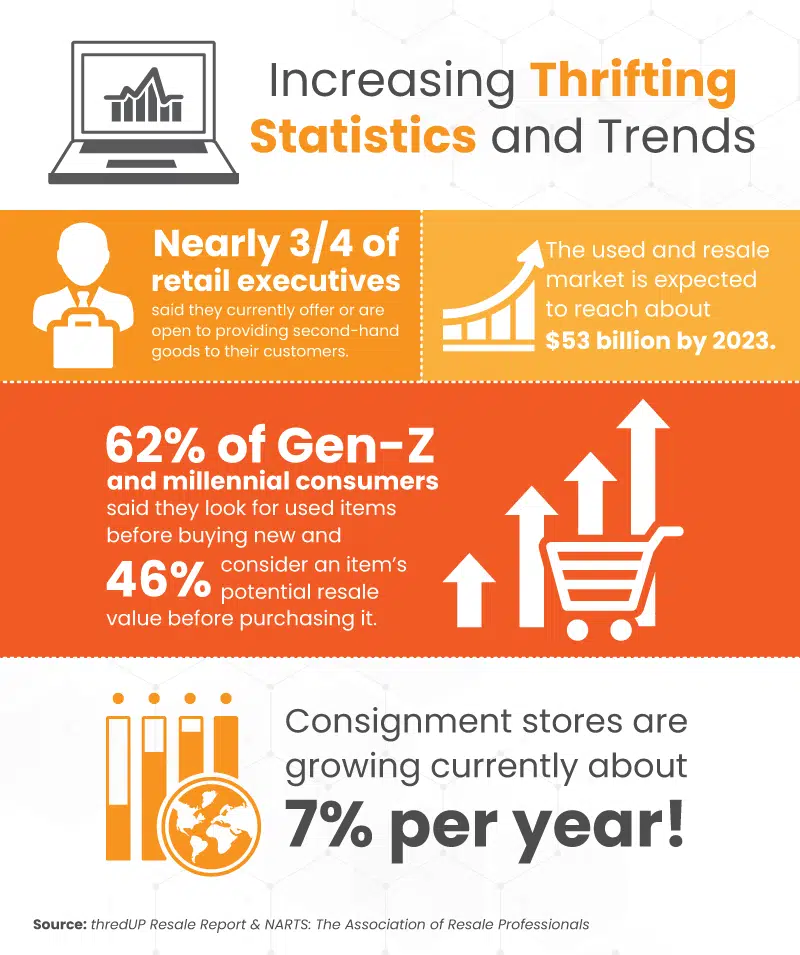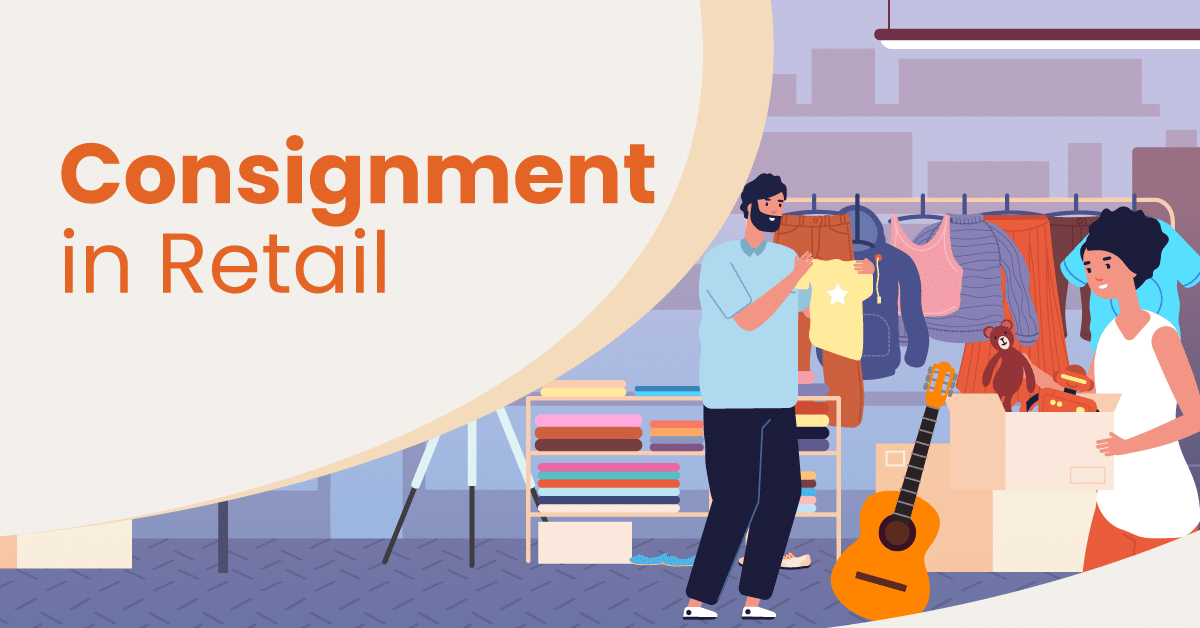Sellers seeking new and expanded wholesale and retail markets for their goods can often leverage consignment sales to their advantage. Doing so can expand your product catalog, target market, and overall sales.
Consignment selling is when goods are shipped to a reseller who pays you, the shipper, only for the goods that sell. Traditionally, it’s a model used by many antique shops, with independent sellers renting space in a larger established shop. This business model continues to grow to other realms, though, with many new consignment companies opening online.
Whether you are looking for your next business idea or want to understand how consignment stores work, this article will walk you through consignment and its advantages and disadvantages for consignees and consignors.

What Is Consignment?
Consignment is a business model in which a reseller (consignee) agrees to pay its supplier (consignor) for merchandise after it has been sold. Consignment goods are typically sold through consignment stores, which receive a percentage of the sale revenue (sometimes a very high percentage) as a commission.
In other words, the supplier entrusts the reseller with products without collecting payment, and the consignor offers them for sale in their store. However, the consignor retains ownership of the products until they are sold, even if they are in the resale business.
Consignment sales involve various products, such as clothing, antiques, collectibles, furniture, toys, shoes, jewelry, etc. In recent years, there has been an increase in eCommerce-based consignment stores. Also, consignment does not typically include large retail chains such as Walmart or most supermarkets, which purchase goods directly from wholesalers and then sell their items at a profit.
How Does The Consignment Model Help Resellers And The Supplier Business?
The consignment model is popular for a reason. Let’s take a look at the benefits to the consignee and the consignor.
Advantages of consignment for consignee
Experiment with selling new products: Many companies do not have the opportunity to experiment with selling products they have never sold before. They don’t want to risk investing in products they are unsure about, not knowing how they will perform in the marketplace. With consignment, these companies can experiment with selling new products without losing money if the products don’t sell.
Return unsold products: In a traditional business, unsold products end up sitting in a warehouse, taking up space and sometimes turning into dead stock. On the other hand, a consignment agreement allows the consignee to return all unsold products to the consignor, thus saving them the additional cost of storing these products.
Avoid lag time: Companies that opt for consignment replenish their inventory as they sell it to eliminate latency. Lag time is the time between the sale of a product and its replenishment. Typically, companies replenish their stock at specific times, such as at the end of the month or quarter, based on how quickly their products sell and the demand they receive. The consignment model, therefore, allows you to avoid the lag time to meet customers’ needs continuously.
Advantages of consignment for consignor
Ensure products reach customers directly: Some products sell better if customers can see and test them before they buy, such as edible products, appliances, etc. Consignment improves a supplier’s sales chances by making products directly available to customers who can purchase them in person. In addition, there is no need to spend time creating listings on eBay, Etsy, or Craigslist to sell items, nor do you need to set up a retail storefront.
Reduce inventory storage costs: No company wants to keep its capital tied up in unsold or deteriorating inventory. Renting or buying a warehouse to store inventory is very expensive and is one of the most common obstacles businesses face. With consignment sales, suppliers can save on storage costs since they distribute their products to other companies and do not store anything.
Products reach a wider customer base: The consignment model allows suppliers or consignors to place goods in wholesale and retail outlets for additional exposure to the buying market. With retail stores and resellers having direct contact with consumers, consignment gives the manufacturer the opportunity to expose the merchandise to the buying market instead of storing it and isolating it in a warehouse while waiting for a buyer’s order.
What Are The Drawbacks Of The Consignment Model?
While consignment can benefit both consignees and consignors, it can also have drawbacks.
Dependence on consignee
Companies that sell consignment products depend on suppliers to provide a steady supply of products. This means that if it turns out that the supplier experiences a delay in the delivery of inventory, the reseller may find itself out of stock for some time.
Consignment also means that resale companies will not be able to keep all of the profits they make and will instead have to share some of it with their suppliers when they pay for the products they have purchased. While consignment is known to be a low-risk business strategy, it is not necessarily very profitable.
Disadvantages for consignors
For vendors, one of the drawbacks of consignment is that you have to wait for payment based on the consignment period established by the store in question. Also, consignors earn less than they could by selling directly to online buyers.
Another disadvantage of the consignment model is that sellers can lose control over how their products are marketed and sold. The consignment store typically takes control of all aspects of marketing and presentation of a given product. This can mean that products are presented in a way that the owner or producer does not approve of. Sometimes this type of problem is covered by consignment agreements, but often consignment sales involve ceding a great deal of control to the consignment seller.
Consignment Statistics & Trends
- The used and resale market is expected to reach about $53 billion by 2023, according to annual forecasts by thredUP, an online resale marketplace.
- The resale business attracts consumers of all economic levels. No one is immune to the excitement of finding a treasure and saving money. Savvy shoppers take advantage of the resale opportunity to save money on clothing, furniture, and other consumer goods. These savings can add quality to life when used for vacations, entertainment, funding for college or retirement accounts, or any number of other things. Most importantly, in this time of inflation, good deals are what most consumers are looking for.
- According to a report released by the Association of Resale Professionals, nearly three-quarters of retail executives said they currently offer or are open to providing second-hand goods to their customers, an increase from 2020, the report said.
- Sixty-two percent of Generation Z and millennial consumers said they look for used items before buying new. And nearly half of Gen Z and millennial consumers (46 percent) consider an item’s potential resale value before purchasing it.
- Consignment store growth is currently about 7% per year, and many consignment stores continue to be established regularly.

KORONA POS can handle your consignment store.
Speak with a product specialist and learn what features and tools are available for your business.
What Is Consignment: Conclusion
Adopting a consignment model can benefit both resellers and their suppliers. For resellers, consignment enables them to save on expenses related to unsold products, try to sell new products safely, and eliminate lag times. As for suppliers, they can reduce inventory costs and provide products directly to buyers in person.
There are some drawbacks to watch out for, but if managed properly, the consignment model can bring in revenue for a business. Online consignment stores are becoming increasingly popular with consumers. Platforms such as Poshmark, Kidizen, and ThredUp are prime examples of growing consignment stores. While the consignment model is not for everyone, it can be a great option to consider if you don’t want to have to produce or create your inventory to sell.
FAQs: What Is Consignment?
The big difference between a thrift store and a consignment store is that consignment stores are usually for-profit organizations, as opposed to thrift stores which are usually based on donations to a charity or non-profit organization.
According to business analysts, a 60/40 split in favor of the consignor is fair. However, the percentage of the sale that consignment stores pay varies based on a wide variety of parameters, such as products, season, and general sales trends. Generally, the owner or manufacturer receives 60% of the sale price of each item, while the consignment store receives 40%. Sometimes the percentage split is equal.
In a resale business model, the company typically offers to purchase an item in advance. The company offers a percentage of the item’s sale in a consignment business model.
It’s a good idea to set the price 50 to 70 percent below the retail price. For example, if you bought a $20 toy for your child, it should be priced between $6 and $10. Clothing is typically priced at $2 to $3 for common styles













